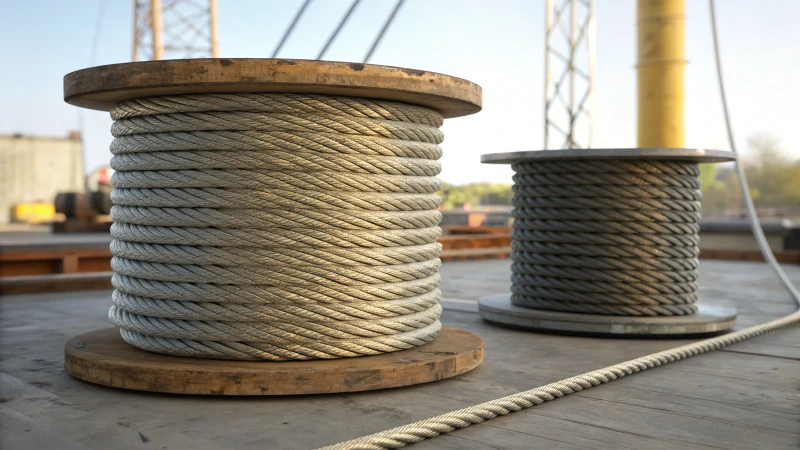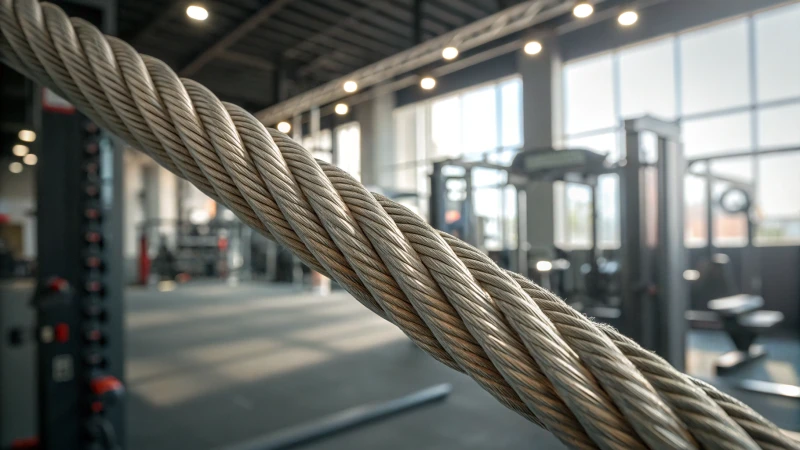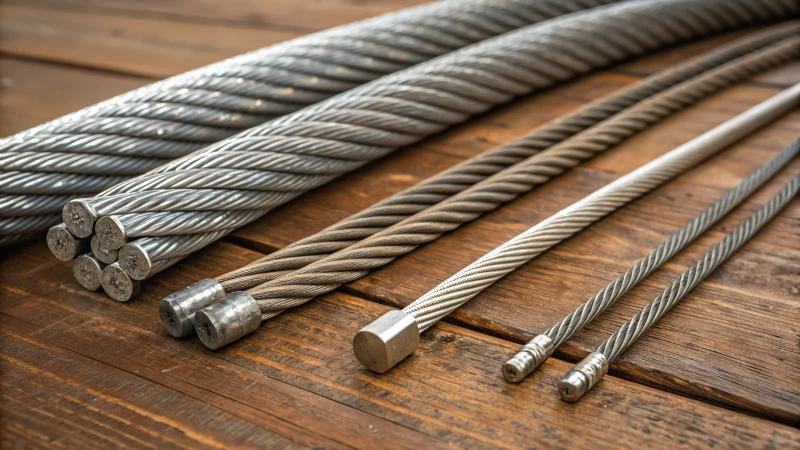
Choosing the right steel wire rope is like picking the right tool for the job—each has its own unique strengths and applications.
Steel wire rope construction involves the pattern of strands and wires, impacting flexibility, strength, and durability. Common types like 6x19, 6x36, and 7x19 are designed for specific uses such as cranes, elevators, or winching systems.
I remember my first project involving heavy machinery. The choice of wire rope was crucial; it wasn't just about lifting weight but ensuring safety and longevity. Understanding the differences between constructions like 6x19 and 6x36 made all the difference. While both offer flexibility and strength, 6x36 provided superior fatigue resistance—ideal for our crane operations. This insight saved us countless hours in maintenance and added peace of mind knowing we had the right rope for the job. Let's dive into how these constructions can influence your project's success.
6x19 wire rope is more flexible than 6x36.False
6x36 wire rope is more flexible due to its higher number of wires.
7x19 wire rope is ideal for winching systems.True
7x19 construction offers flexibility and strength, perfect for winching.
How does the 6x19 construction compare to 6x36?
Choosing the right wire rope is like picking the perfect tool for a job—it’s all about fit and function.
The 6x19 wire rope offers a solid mix of strength and flexibility, ideal for many tasks. Meanwhile, 6x36 shines with its superior fatigue resistance, perfect for frequent bending scenarios.

Understanding Wire Rope Construction
I remember the first time I had to choose a wire rope for a project. The numbers seemed cryptic—until I learned that the '6' in 6x19 stands for six strands, and '19' refers to the wires per strand. Suddenly, it made sense how this affected the rope’s behavior.
Wire ropes are composed of multiple strands of wires twisted together. This configuration impacts the rope's characteristics.
Comparing Flexibility and Strength
6x19 Construction
- Flexibility: When I used this for general-purpose tasks, its moderate flexibility was just right.
- Strength: It struck a good balance; I didn’t have to compromise too much on strength for flexibility.
6x36 Construction
- Flexibility: I found its flexibility impressive, thanks to more wires per strand.
- Strength: While its tensile strength isn’t as high as 6x19, the flexibility more than makes up for it.
| Construction | Flexibility | Strength |
|---|---|---|
| 6x19 | Moderate | High |
| 6x36 | High | Moderate |
Fatigue Resistance
In dynamic environments, fatigue resistance is key. I’ve seen how crucial this can be firsthand.
- 6x19: It offers decent fatigue resistance but sometimes falls short in demanding conditions.
- 6x36: Its enhanced fatigue resistance makes it a go-to for cranes and elevators, handling movement with ease.
The ability to withstand repeated bending without breaking is crucial for wire ropes in dynamic environments.
Practical Applications
6x19 Construction
- When strength is a must and flexibility isn’t the top priority, this is your rope. I’ve used it often on construction1 sites and with industrial machinery2.
6x36 Construction
- For high flexibility and superior fatigue resistance, this is unbeatable. Perfect for marine operations3 and elevator systems4, as I’ve seen in my projects.
Understanding these nuances ensures safety and efficiency across different applications. When selecting the right wire rope, aligning it with your specific needs can make all the difference.
6x19 wire rope is more flexible than 6x36.False
6x36 construction is more flexible due to higher wire count per strand.
6x36 wire rope has better fatigue resistance than 6x19.True
6x36 offers improved fatigue resistance, ideal for dynamic environments.
Why is 7x19 Wire Rope So Effective in Various Applications?
Ever wondered why 7x19 wire rope is a game-changer in many industries?
The 7x19 wire rope is perfect for applications needing flexibility and strength, like winching systems, garage doors, and gym equipment. Its design withstands frequent bending and dynamic loads.

Understanding 7x19 Wire Rope Structure
When I first learned about the 7x19 wire rope, I was struck by its intricate design—seven strands with 19 wires each. It's like the perfect symphony of flexibility and strength5! This configuration really shines when the rope needs to twist and turn around pulleys or endure repeated bending without losing its integrity.
Key Applications of 7x19 Wire Rope
Winching Systems
I remember the first time I saw a winching system in action; the 7x19 wire rope effortlessly handled continuous tension. This rope is a workhorse in winching systems, managing dynamic loads with grace and ensuring operations remain safe and reliable.
Garage Doors
Have you ever watched a garage door open smoothly, as if it were gliding on air? That's the magic of 7x19 wire ropes at work. Their flexibility ensures minimal wear, allowing for seamless operation over countless cycles.
Fitness Equipment
Picture this: you're at the gym, cranking out reps on a cable machine6, and it's the 7x19 wire rope that’s keeping everything moving smoothly. This rope's robust construction is vital for maintaining durability during consistent workouts.
Comparing Wire Rope Configurations
| Configuration | Strands x Wires | Best For |
|---|---|---|
| 6x19 | 6 x 19 | General lifting |
| 6x36 | 6 x 36 | High fatigue resistance |
| 7x19 | 7 x 19 | Flexibility-demanding tasks |
Factors Influencing Wire Rope Selection
When I'm selecting a wire rope, I consider several factors:
- Load Requirements: What's the heaviest load the rope will need to handle?
- Environmental Conditions: Will it face moisture or chemicals?
- Operational Flexibility: Does the application involve frequent bending or movement?
By keeping these considerations in mind, procurement managers can make informed choices, ensuring they pick the right wire rope for their needs. The choice of construction7 impacts performance and longevity across various applications.
7x19 wire rope is best for general lifting tasks.False
The 7x19 wire rope is ideal for flexibility-demanding tasks, not general lifting.
Fitness equipment benefits from 7x19 wire rope's flexibility.True
The 7x19 wire rope supports constant motion, perfect for gym cable machines.
Why Is Fatigue Resistance Important in Wire Ropes?
Have you ever paused to think about what keeps our skyscrapers standing tall and our mines safe from collapse?
Fatigue resistance in wire ropes is crucial because it helps them endure repeated stress and bending, ensuring both safety and longevity in dynamic, high-load environments.

Understanding Fatigue Resistance in Wire Ropes
I remember the first time I truly appreciated the importance of fatigue resistance. It was during a project where we were hoisting massive beams for a new bridge. Watching those wire ropes hold steady despite the repetitive stress left a lasting impression on me. Fatigue resistance is all about a rope's ability to withstand these cyclic stresses over time without snapping like a twig.
When you think about cranes or elevators, imagine the constant bending and stress they endure. That's where fatigue resistance steps in to save the day. The secret lies in the construction of these ropes. Take the 6x36 construction, for example. With more wires per strand than the 6x19, it's like having a superpower against fatigue—perfect for environments where bending is as frequent as my morning coffee runs.
Key Factors Influencing Fatigue Resistance
There are several key factors that play into how well a wire rope can handle fatigue:
| Factor | Description |
|---|---|
| Material | High-quality steel enhances fatigue resistance. |
| Construction | More wires per strand generally improve flexibility and fatigue life. |
| Lubrication | Proper lubrication reduces friction, increasing fatigue life. |
It's like choosing between two types of shoes for a marathon; one gives you comfort (flexibility), while the other offers durability (fatigue resistance). For instance, using a 7x19 construction might feel like running shoes with extra bounce, but in terms of fatigue resistance, it's not quite up there with a 6x36.
Applications Benefiting from Fatigue Resistance
Think about a mining operation, where heavy-duty ropes face conditions harsher than a summer day in the Sahara. In such settings, fatigue-resistant ropes8 are not just beneficial—they're lifesavers. They keep the machinery humming without the dreaded downtime that eats into budgets and timelines.
In my experience working with construction sites, selecting the right rope construction and material can make or break a project—literally. It's about ensuring reliability and safety in environments where every second counts. By making informed choices, businesses can boost both efficiency and safety standards, keeping everything—and everyone—up and running smoothly.
6x36 wire ropes have better fatigue resistance than 6x19.True
More wires per strand in 6x36 enhance flexibility and fatigue life.
7x19 construction offers superior fatigue resistance to 6x36.False
7x19 is more flexible but less fatigue-resistant than 6x36.
How do I choose the right steel wire rope for my project?
Choosing the perfect steel wire rope feels like solving a puzzle where every piece matters to ensure safety and efficiency.
To select the right steel wire rope, think about load capacity, flexibility, construction type (like 6x19 or 6x36), and environmental conditions. Align these with your project's unique demands for optimal results.

When I first ventured into selecting steel wire ropes, I felt like I was wading through a maze of options, each with its own set of strengths and quirks. It's essential to understand the basic types to make an informed decision.
Understanding Steel Wire Rope Construction Types
The construction type of a steel wire rope significantly impacts its performance. Take, for instance, the 6x19 construction, which I found to be quite versatile, balancing flexibility and strength perfectly for general use. Meanwhile, the 6x36 construction stands out for its superior fatigue resistance—a lifesaver for projects involving cranes.
| Construction Type | Applications | Features |
|---|---|---|
| 6x19 | General use | Flexibility and strength |
| 6x36 | Cranes | High fatigue resistance |
Comparing Material Properties
Material choice is equally critical. Stainless steel ropes9, for example, offer fantastic corrosion resistance. I remember the relief I felt when these ropes held up beautifully in a marine environment, saving us from potential setbacks.
Evaluating Environmental Conditions
I can't stress enough how important it is to consider where the rope will be used. In marine applications, for instance, high corrosion resistance is non-negotiable due to saltwater exposure.
Load Capacity and Tensile Strength
Choosing a wire rope based on load capacity and tensile strength is crucial. You want something that can handle not just the weight but also any additional stresses like tension and dynamic loads.
Importance of Safety Standards
A lesson learned the hard way: never compromise on safety standards. Ensuring that your chosen rope complies with local and international standards can mean the difference between smooth operations and costly accidents.
Supplier Selection Criteria
Finally, finding a reliable supplier is like finding a good friend. Look for those who offer robust after-sales support and technical assistance. Building long-term partnerships can guarantee consistent quality and timely delivery of materials. Trust me, it makes all the difference.
6x19 steel wire rope is ideal for cranes.False
6x19 is more suited for general use, not specifically cranes.
Stainless steel ropes resist marine corrosion.True
Stainless steel offers excellent corrosion resistance in marine environments.
Conclusion
Explore the various types of steel wire rope constructions, including 6x19, 6x36, and 7x19, each designed for specific applications based on flexibility, strength, and fatigue resistance.
-
Explore how 6x19 ropes are used in construction for tasks requiring strength. ↩
-
Learn about industrial machines that benefit from the strength of 6x19 ropes. ↩
-
Discover why marine applications prefer the flexible and durable 6x36 ropes. ↩
-
Understand how elevators achieve reliability with 6x36 ropes' flexibility. ↩
-
This link provides insights into how flexibility and strength are balanced in wire ropes, crucial for selecting the right type for your needs. ↩
-
Explore the advantages of using cable machines in fitness settings, highlighting how the right wire rope enhances gym equipment efficiency. ↩
-
Learn about how different wire rope constructions affect their performance in various applications, aiding in informed decision-making. ↩
-
Dynamic loads necessitate strong fatigue resistance; exploring this link reveals how these demands shape wire rope performance. ↩
-
Stainless steel wire ropes are known for their corrosion resistance, making them ideal for harsh environments. ↩

